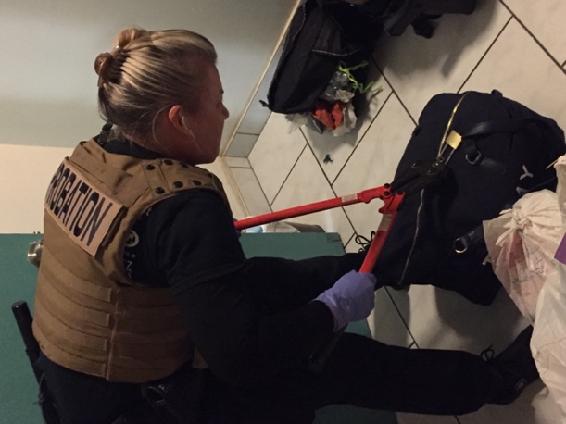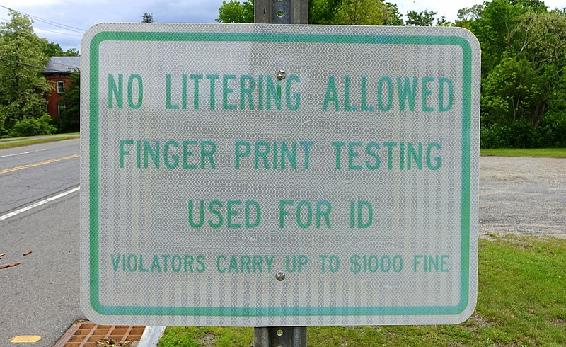2.6: Types of Sentences
- Page ID
- 25808
A sentence is the punishment ordered by the court for a convicted defendant. Statutes usually prescribe punishments at both the state and federal level. The most important limit on the severity of punishments in the United States is the Eighth Amendment.
The Death Penalty
The death penalty is a sentencing option in thirty-eight states and the federal government. It is usually reserved for those convicted of murders with aggravating circumstances. Because of the severity and irrevocability of the death penalty, its use has heavily circumscribed by statutes and controlled by case law. Included among these safeguards is an automatic review by appellate courts.
Think About It . . . The Death Penalty
The death penalty remains a controversial type of correction in the United States [click here to take a virtual tour of San Quentin Prison lethal Injection facility]. In America there are many pro and con arguments concerning the death penalty, with educated and qualified individuals on both sides of the debate. What do you think about the use of the death penalty as a criminal sentence?
Incarceration
The most common punishment after fines in the United States is the deprivation of liberty known as incarceration. Jails are short-term facilities, most often run by counties under the auspices of the sheriff's department. Jails house those awaiting trial and unable to make bail, and convicted offenders serving short sentences or waiting on a bed in a prison. Prisons are long-term facilities operated by state and federal governments. Most prison inmates are felons serving sentences of longer than one year.
Probation
Probation serves as a middle ground between no punishment and incarceration. Convicts receiving probation are supervised within the community and must abide by certain rules and restrictions. If they violate the conditions of their probation, they can have their probation revoked and can be sent to prison. Common conditions of probation include obeying all laws, paying fines and restitution as ordered by the court, reporting to a probation officer, not associating with criminals, not using drugs, submitting to searches, and submitting to drug tests.
The heavy use of probation is controversial. When the offense is nonviolent, the offender is not dangerous to the community, and the offender is willing to make restitution, then many agree that probation is a good idea. Due to prison overcrowding, judges have been forced to place more and more offenders on probation rather than sentencing them to prison.
Intensive Supervision Probation (ISP)
Intensive Supervision Probation (ISP) is similar to standard probation but requires much more contact with probation officers and usually has more rigorous conditions of probation. The primary focus of adult ISP is to provide protection of the public safety through close supervision of the offender. Many juvenile programs, and an increasing number of adult programs, also have a treatment component that is designed to reduce recidivism.

Figure 2.1 Probation Officer Search by Tabitha Raber is used under a CC BY 4.0 license.
Boot Camps
Convicts, often young men, sentenced to boot camps live in a military style environment complete with barracks and rigorous physical training. These camps usually last from three to six months, depending on the particular program. The core ideas of boot camp programs are to teach wayward youths’ discipline and accountability. While a popular idea among some reformers, the research shows little to no impact on recidivism.
House Arrest and Electronic Monitoring
The Special Curfew Program was the federal courts' first use of home confinement. It was part of an experimental program-a cooperative venture of the Bureau of Prisons, the U.S. Parole Commission, and the federal probation system-as an alternative to Bureau of Prisons Community Treatment Center (CTC) residence for eligible inmates. These inmates, instead of CTC placement, received parole dates advanced a maximum of 60 days and were subject to a curfew and minimum weekly contact with a probation officer. Electronic monitoring became part of the home confinement program several years later.

Figure 2.2 Electronic Bracelet. Creative Commons Attribution-Share Alike 3.0 Unported.
In 1988, a pilot program was launched in two districts to evaluate the use of electronic equipment to monitor persons in the curfew program. The program was expanded nationally in 1991 and grew to include offenders on probation and supervised release and defendants on pretrial supervision as those who may be eligible to be placed on home confinement with electronic monitoring (Courts, 2015).
Today, most jurisdictions stipulate that offenders sentenced to house arrest must spend all or most of the day in their own homes. The popularity of house arrest has increased in recent years due to monitoring technology that allows a transmitter to be placed on the convict's ankle, allowing compliance to be remotely monitored. House arrest is often coupled with other sanctions, such as fines and community service. Some jurisdictions have a work requirement, where the offender on house arrest is allowed to leave home for a specified window of time in order to work.
Fines

Figure 2.3 "No Littering Allowed, Finger Print Testing used for ID" - Bernardston, Massachusetts, USA. Image has been designated to the public domain under a CC0 1.0 Universal Public Domain Dedication.
Fines are very common for violations and minor misdemeanor offenses. First time offenders found guilty of simple assaults, minor drug possession, traffic violations and so forth are sentenced to fines alone. If these fines are not paid according to the rules set by the court, the offender is jailed. Many critics argue that fines discriminate against the poor. A $200 traffic fine means very little to a highly paid professional but can be a serious burden on a college student with only a part-time job. Some jurisdictions use a sliding scale that bases fines on income known as day fines. They are an outgrowth of traditional fining systems, which were seen as disproportionately punishing offenders with modest means while imposing no more than "slaps on the wrist" for affluent offenders.
This system has been very popular in European countries such as Sweden and Germany. Day fines take the financial circumstances of the offender into account. They are calculated using two major factors: The seriousness of the offense and the offender's daily income. The European nations that use this system have established guidelines that assign points ("fine units") to different offenses based on the seriousness of the offense. The range of fine units varies greatly by country. For example, in Sweden the range is from 1 to 120 units. In Germany, the range is from 1 to 360 units.
The most common process is for court personnel to determine the daily income of the offender. It is common for family size and certain other expenses to be taken into account.
Restitution
When an offender is sentenced to a fine, the money goes to the state. Restitution requires the offender to pay money to the victim. The idea is to replace the economic losses suffered by the victim because of the crime. Judges may order offenders to compensate victims for medical bills, lost wages, and the value of property that was stolen or destroyed. The major problem with restitution is actually collecting the money on behalf of the victim. Some jurisdictions allow practices such as wage garnishment to ensure the integrity of the process. Restitution can also be made a condition of probation, whereby the offender is imprisoned for a probation violation is the restitution is not paid.
Community Service
As a matter of legal theory, crimes harm the entire community, not just the immediate victim. Advocates see community service as the violator paying the community back for the harm caused. Community service can include a wide variety of tasks such as picking up trash along roadways, cleaning up graffiti, and cleaning up parks. Programs based on community service have been popular, but little is known about the impact of these programs on recidivism rates.

Figure2.4 On Sept. 8, 2015, inmates at Coyote Ridge Corrections Center watered, fertilized and thinned sagebrush plants. Attribution 2.0 Generic (CC BY 2.0)
Pin It! Prisoners in Community Service
Follow the link to learn more about how inmates at a correction center in Oregon are preserving the vital ecosystems of National parks.
"Scarlet-letter" Punishments
While exact practices vary widely, the idea of scarlet-letter punishments is to shame the offender. Advocates view shaming as a cheap and satisfying alternative to incarceration. Critics argue that criminals are not likely to mend their behavior because of shame. There are legal challenges that of kept this sort of punishment from being widely accepted. Appeals have been made because such punishments violate the Eighth Amendment ban on cruel and unusual punishment. Others have been based on the idea that they violate the First Amendment by compelling defendants to convey a judicially scripted message in the form of forced apologies, warning signs, newspaper ads, and sandwich boards. Still other appeals have been based on the notion that shaming punishments are not specifically authorized by State sentencing guidelines and therefore constitute an abuse of judicial discretion (Litowitz, 1997).

